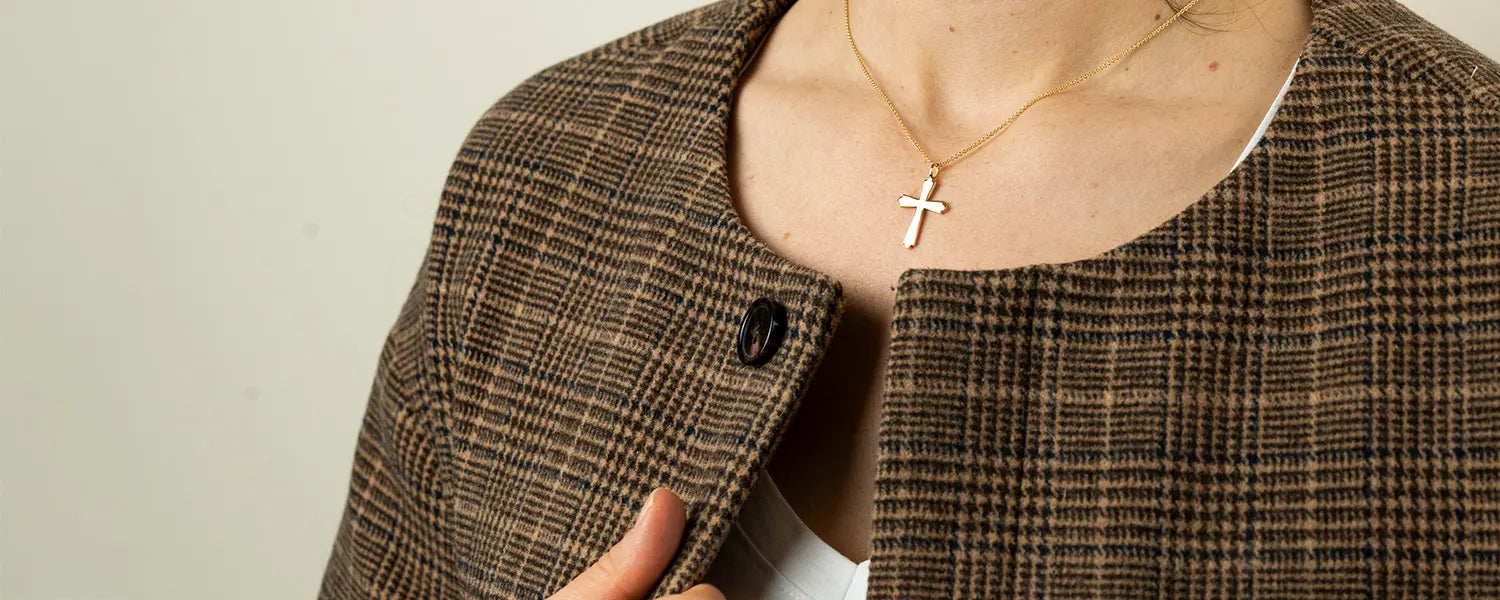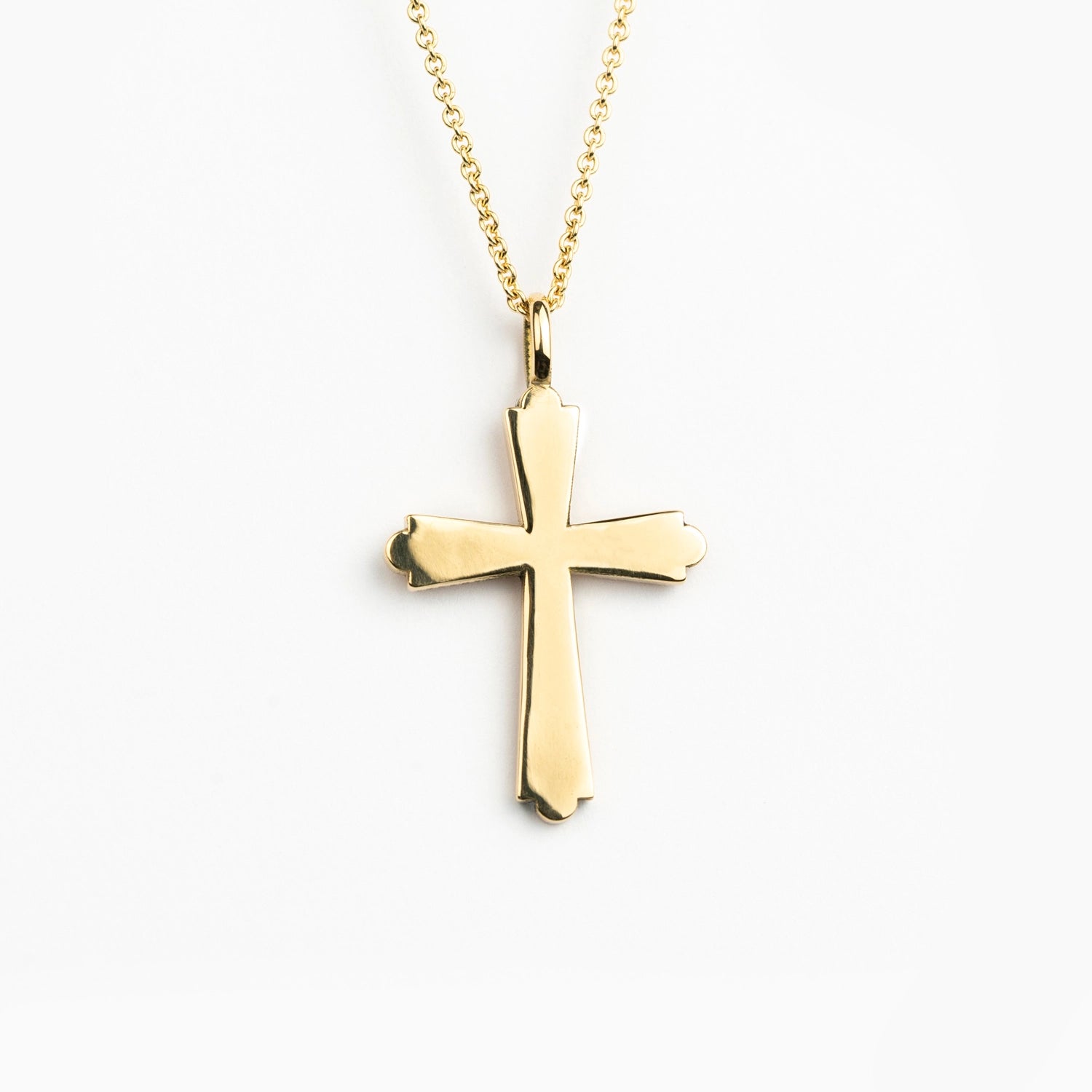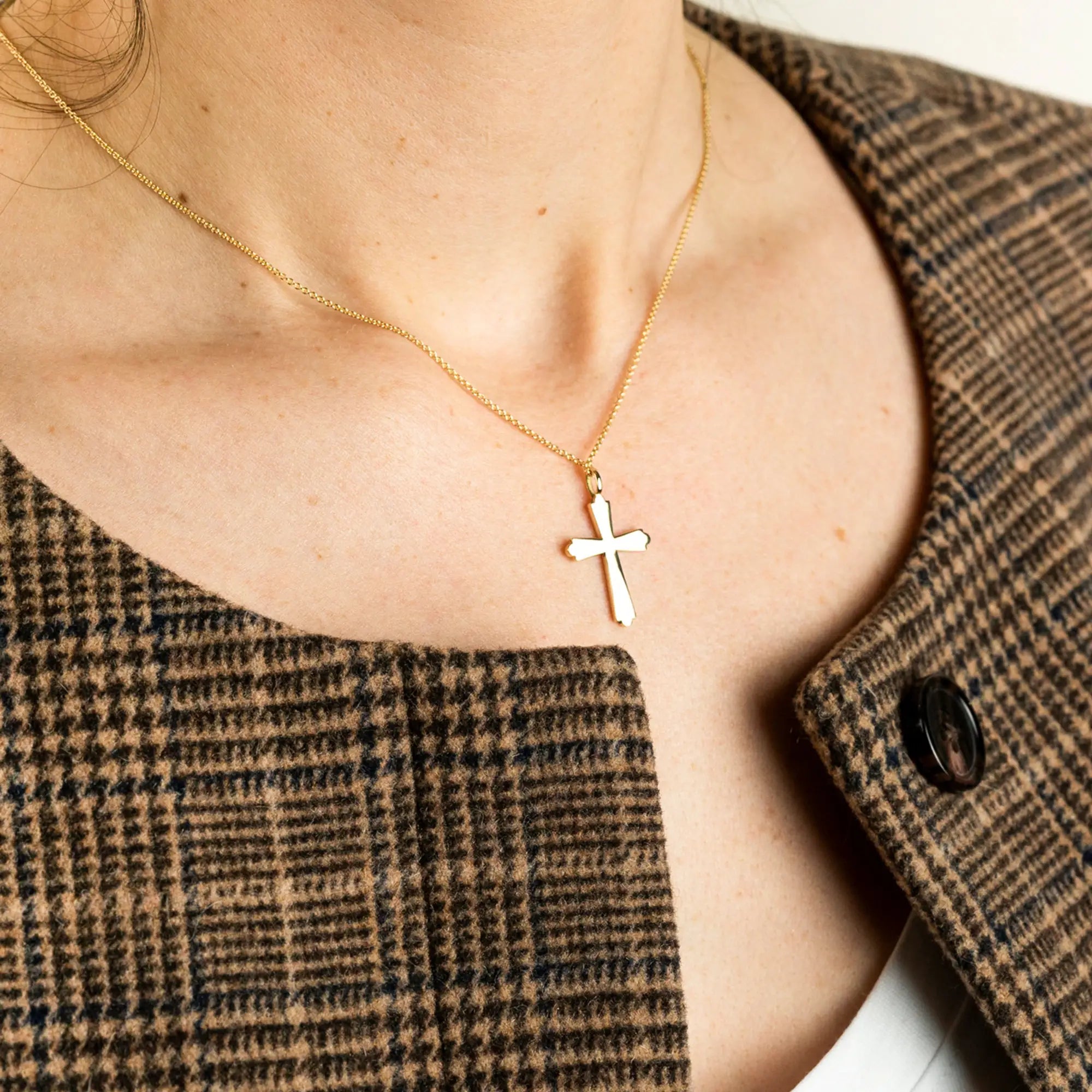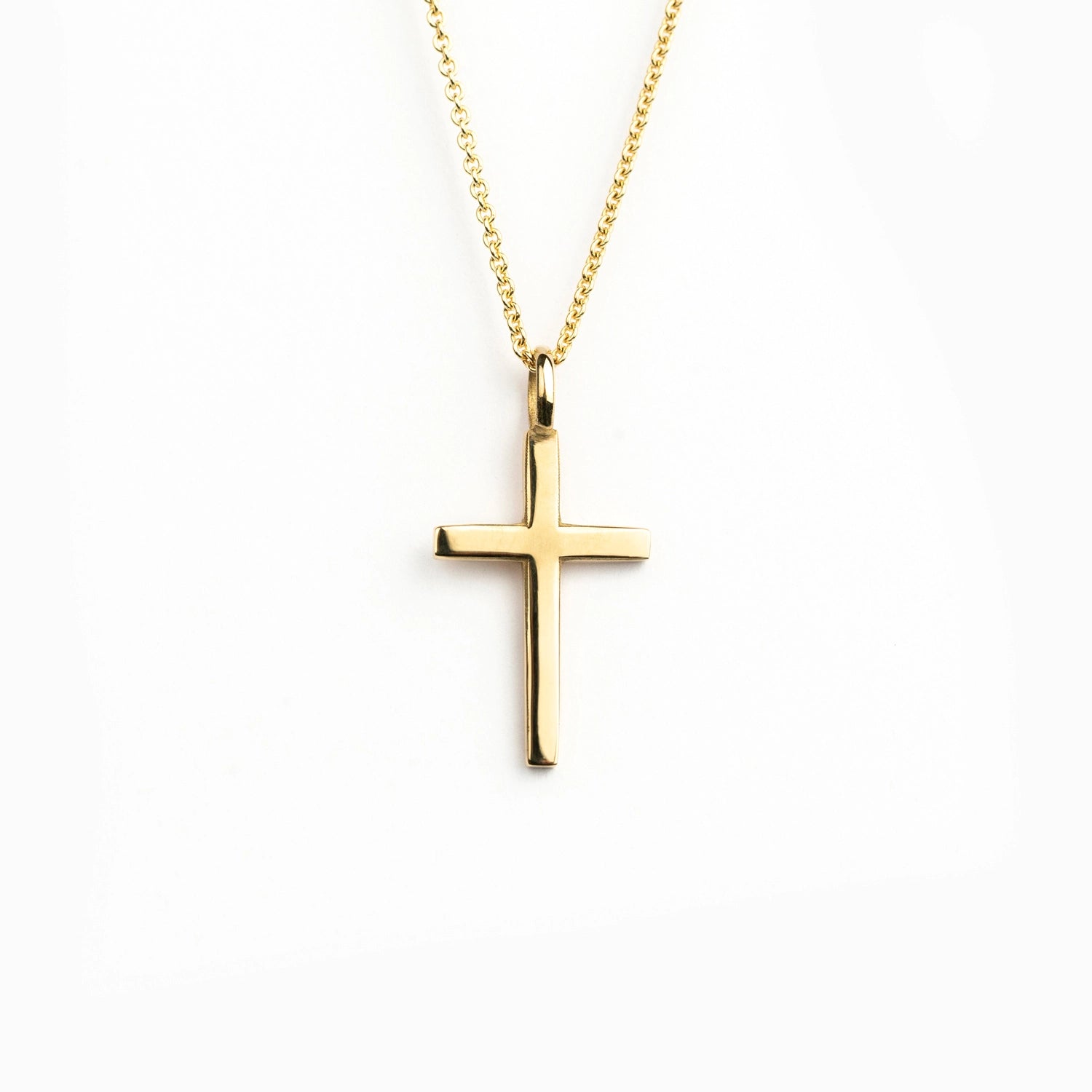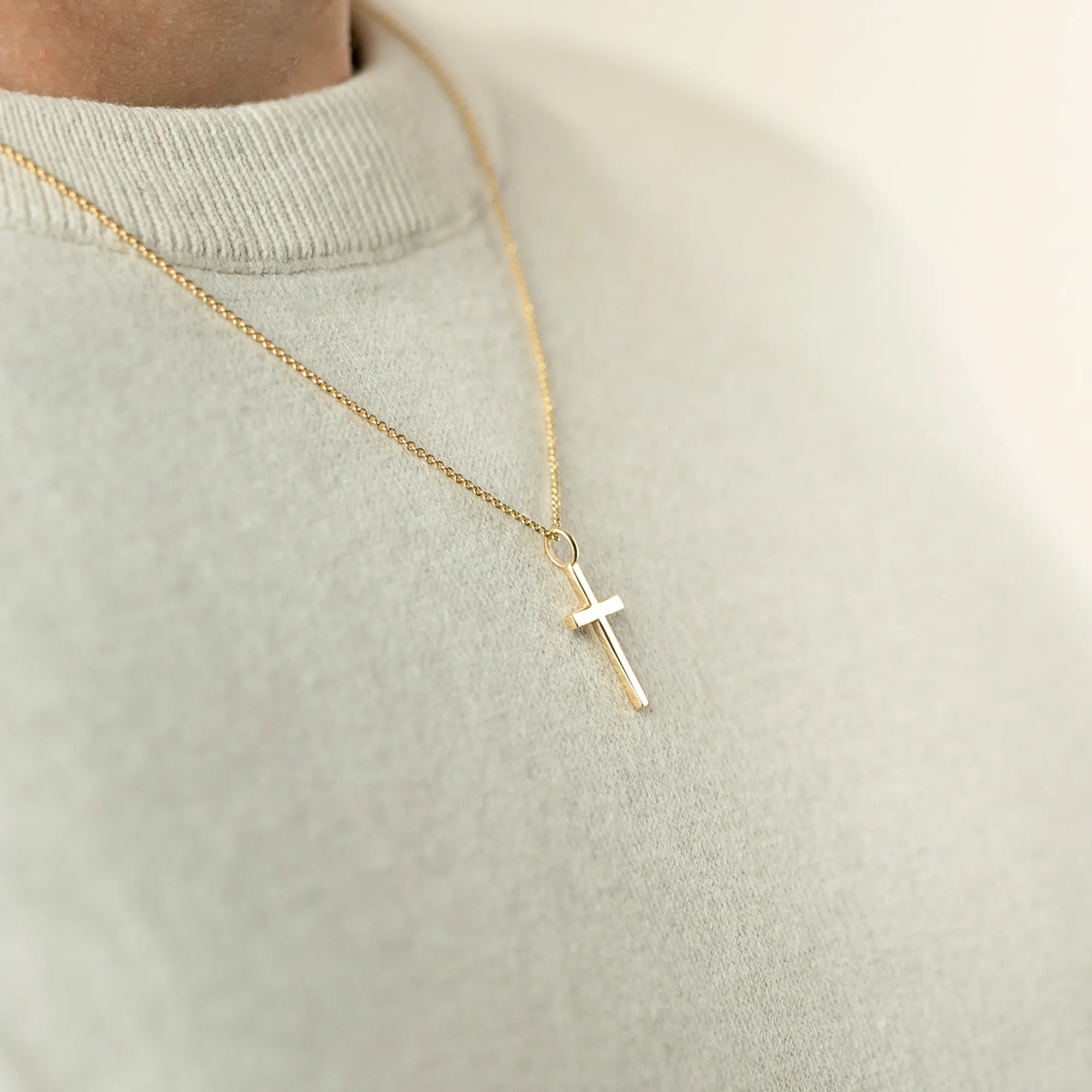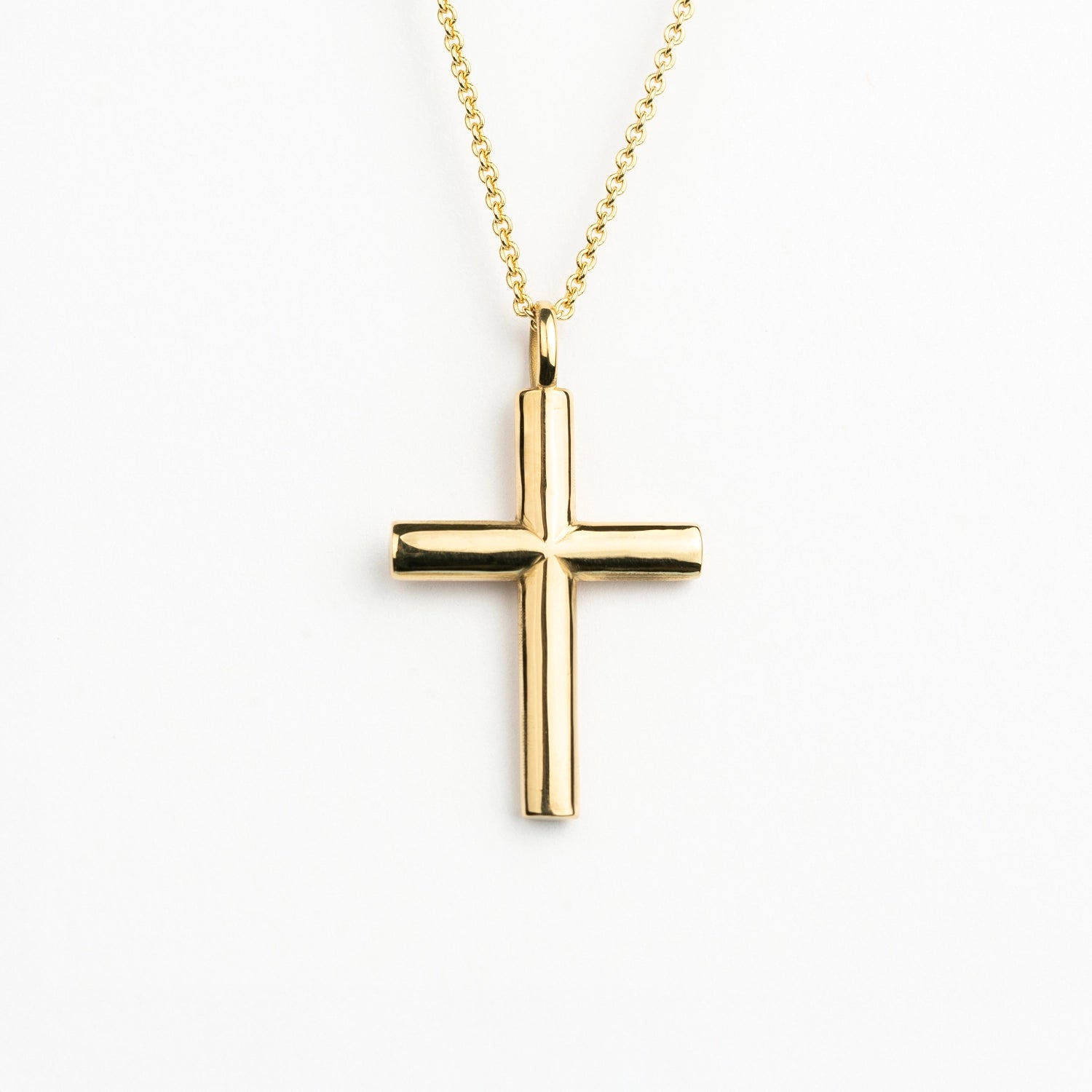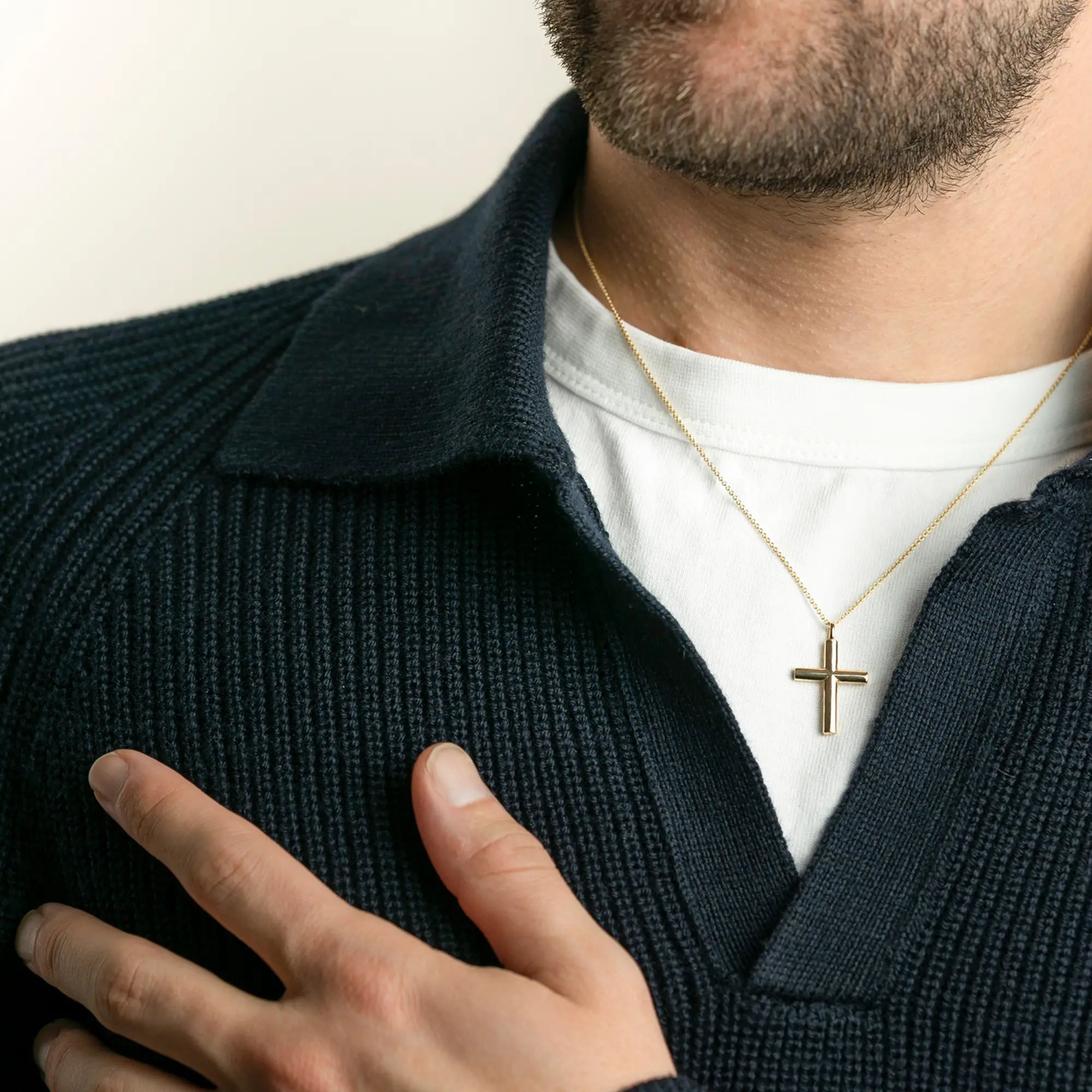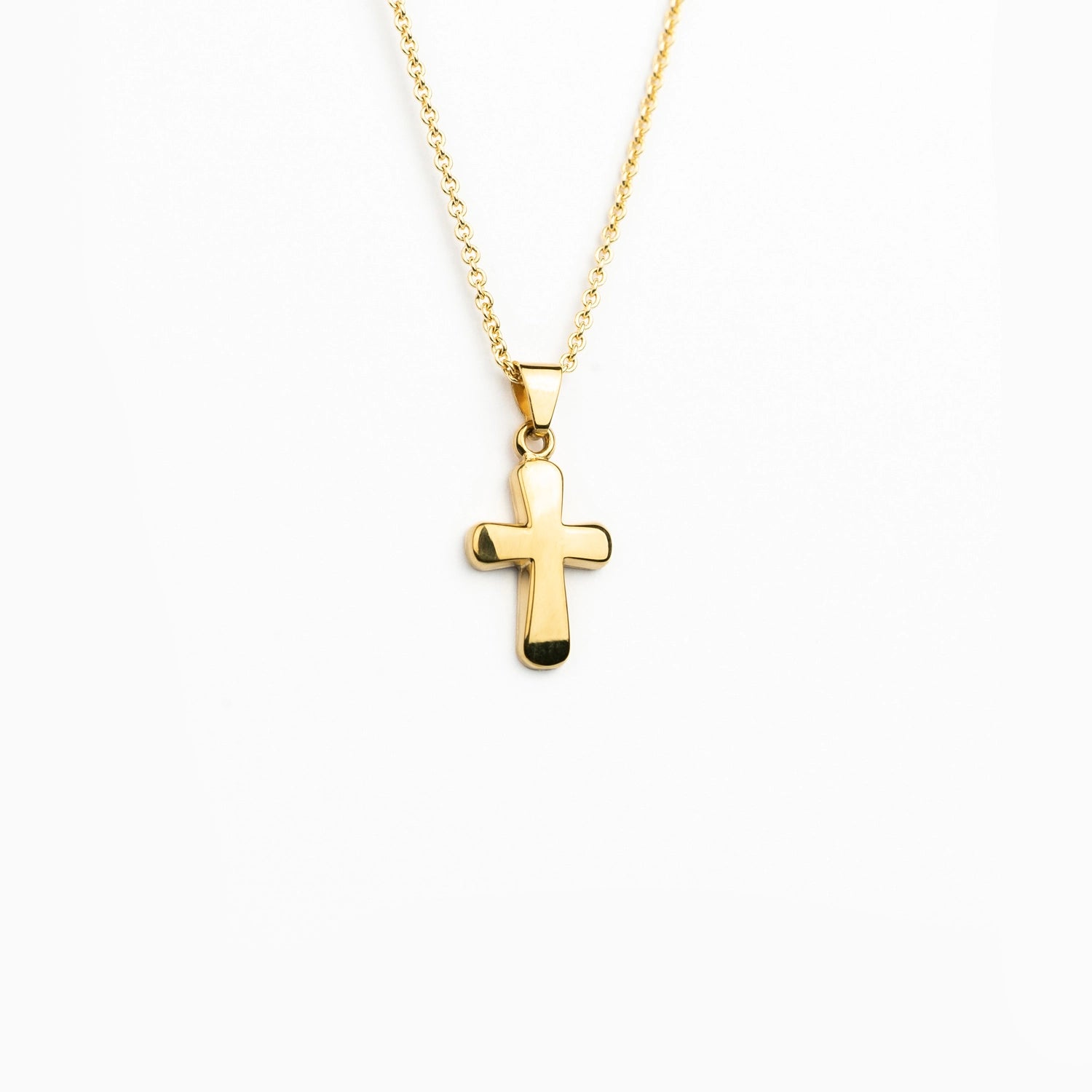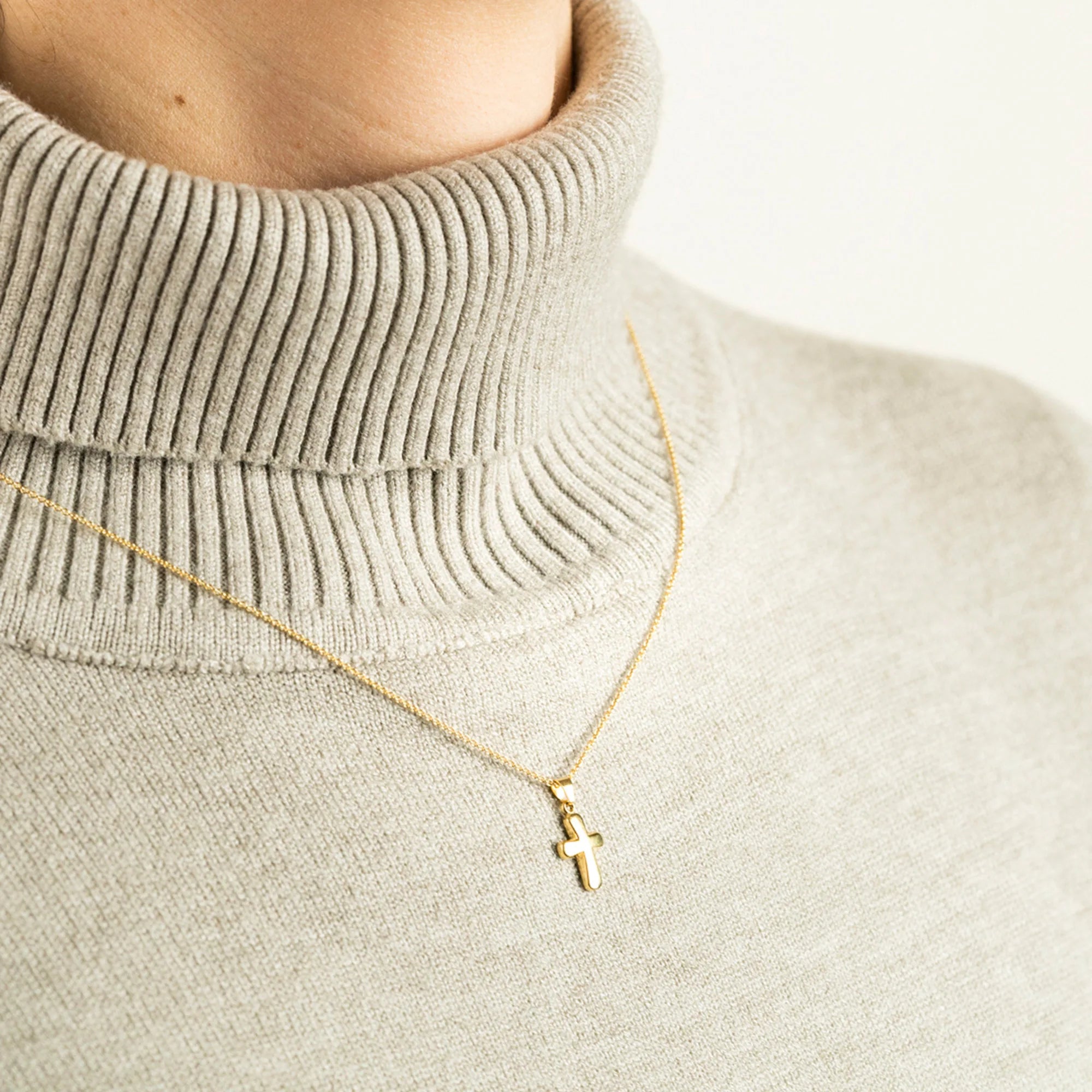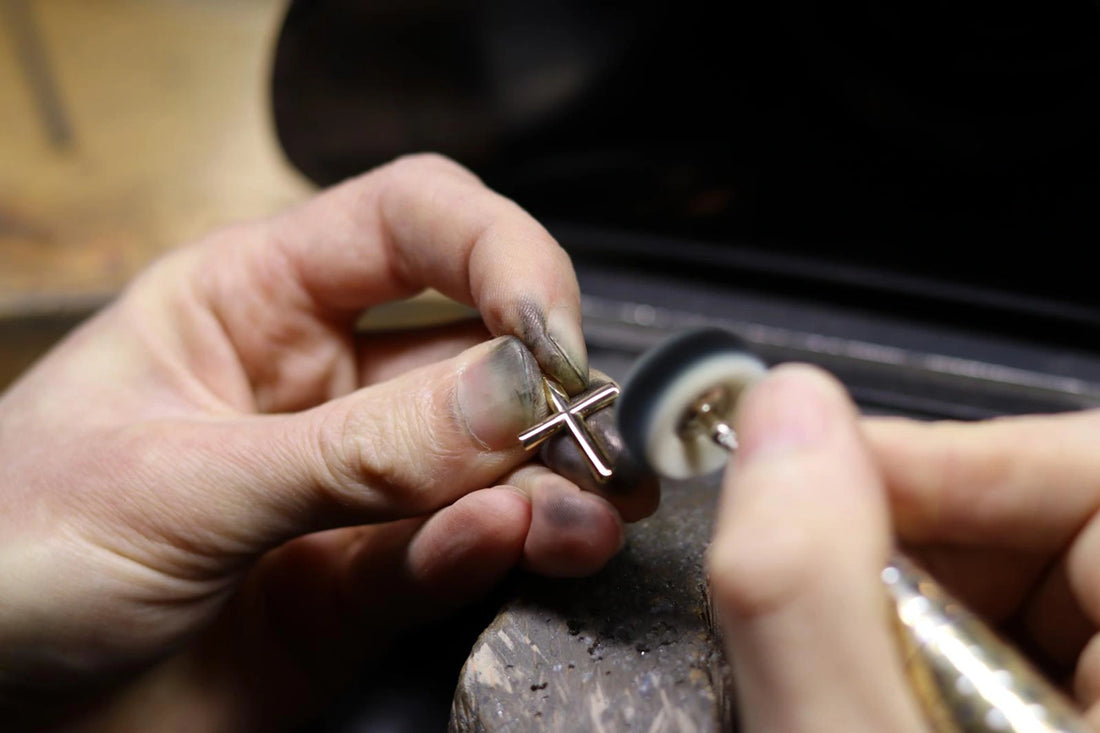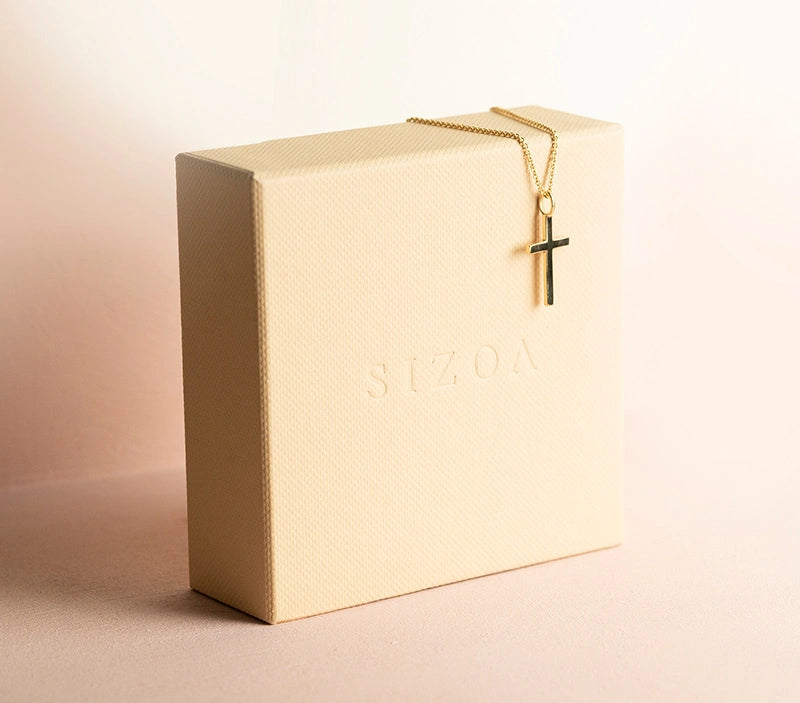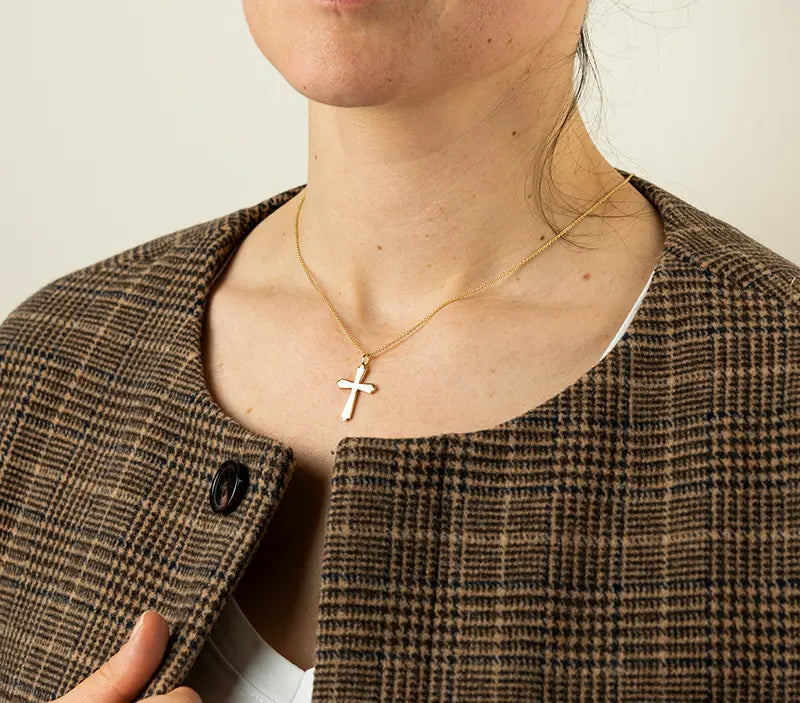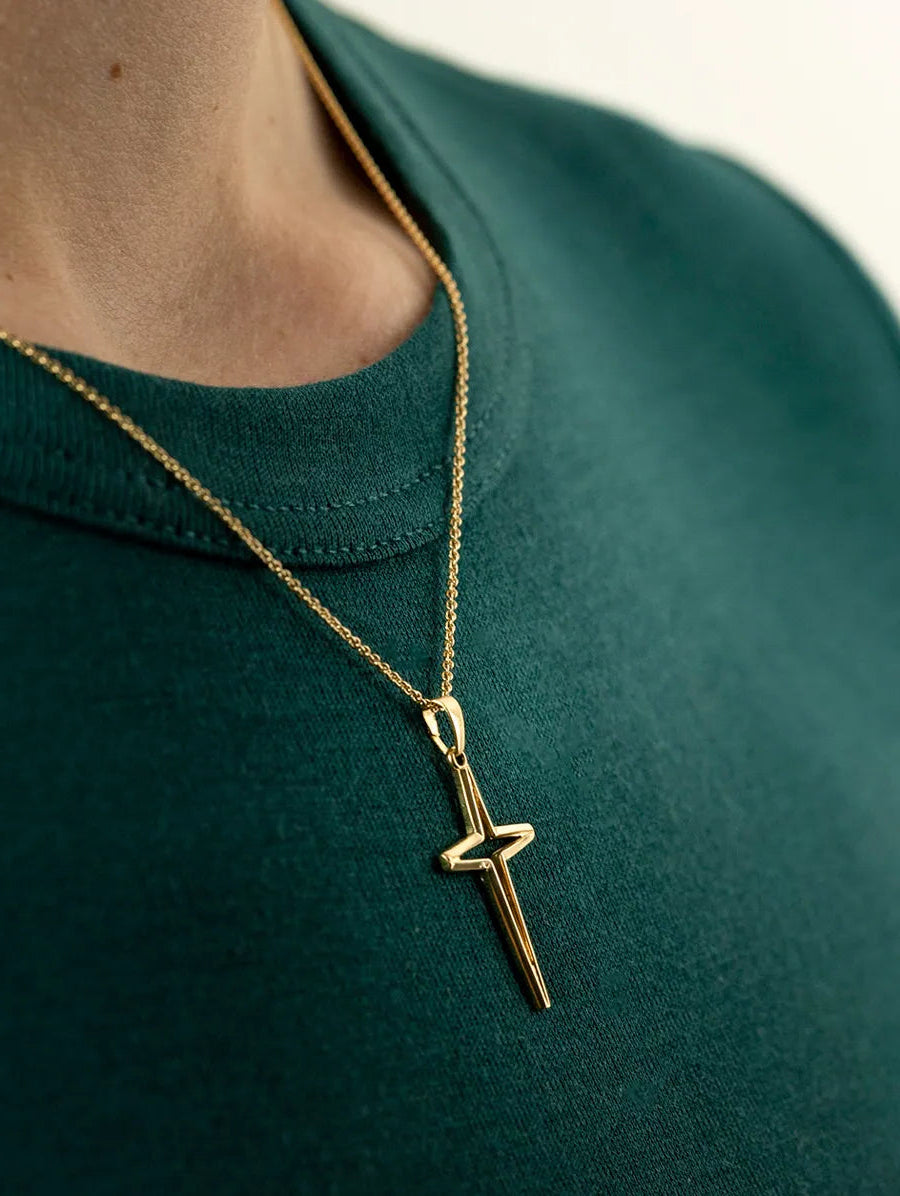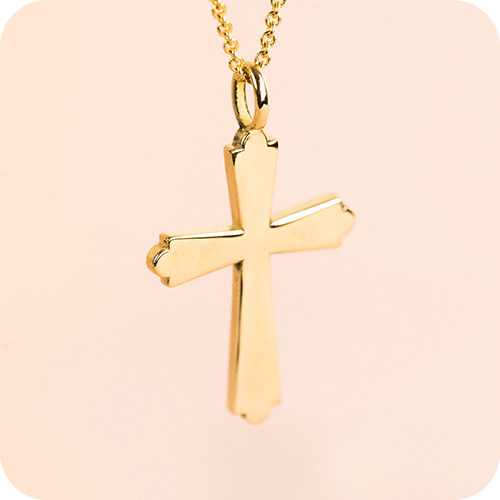The Perfect Cross Necklace for Every Occasion
Discover our exquisite collection of cross necklaces, where timeless faith meets contemporary elegance. From minimalist sterling silver designs to bold gold creations, our selection caters to every style preference and occasion. Whether you seek a subtle everyday pendant or a statement piece for special moments, our cross necklaces blend spiritual significance with sophisticated craftsmanship in gold and silver variations.
Type: GOLD NECKLACE
Certified
We are committed to creating timeless cross necklaces that honor their spiritual significance while embracing modern design and Swiss craftsmanship.
Free Shipping
Sizoa delivers elegance and spirituality to your doorstep, wherever you are in the world. With reliable international shipping partners, we ensure that your cross necklace arrives safely and promptly.
Delivery & Returns
We believe in your complete satisfaction. If your cross necklace doesn’t meet your expectations, we offer a straightforward return process. Simply contact our customer support team
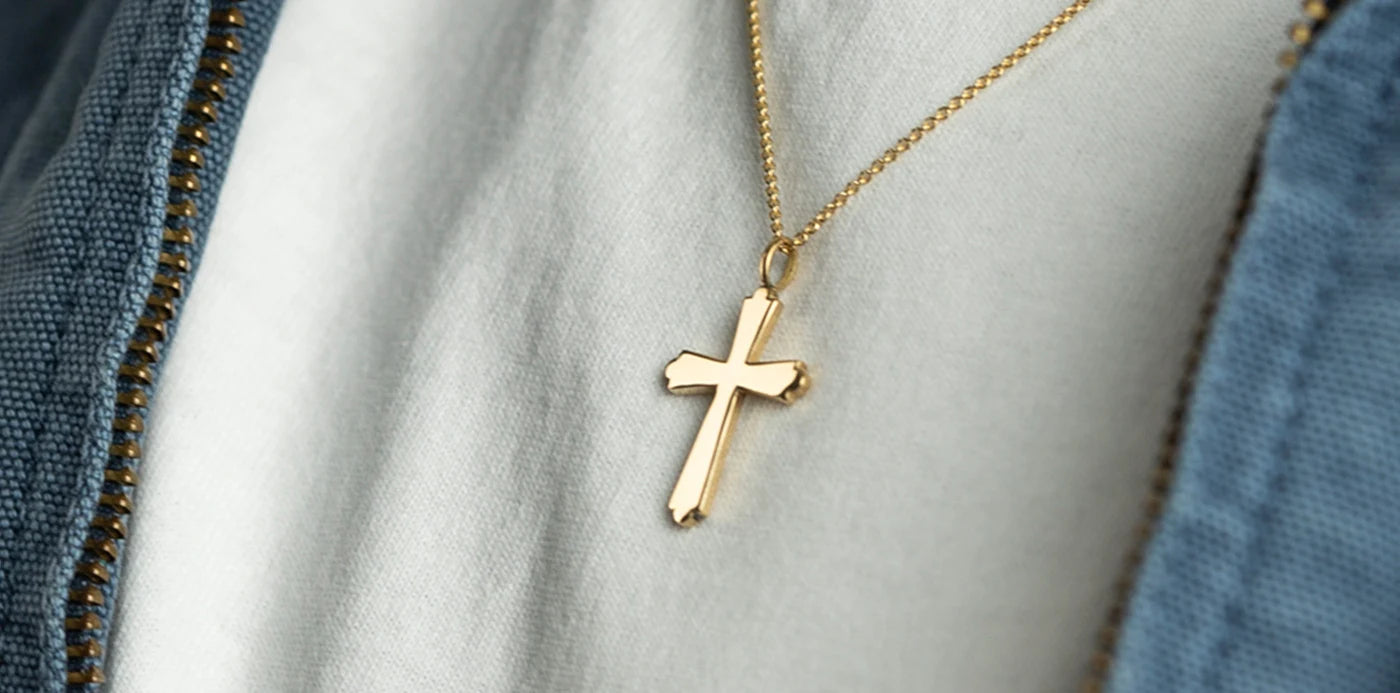
FAQ about buying cross necklace online
What materials are the cross necklaces made of?
What materials are the cross necklaces made of?
Our cross necklaces are crafted exclusively from 18k gold, chosen for its exceptional beauty, durability, and timeless elegance.
Can I choose the chain length?
Can I choose the chain length?
Yes, you can select from a variety of chain lengths to suit your preference, including 15 inches (38 cm), 16 inches (40 cm), 17 inches (42 cm), 18 inches (45 cm), 20 inches (50 cm), 22 inches (55 cm), and 24 inches (60 cm). Find your necklace length
Are the cross pendant unisex or gender-specific?
Are the cross pendant unisex or gender-specific?
Our necklaces are designed with a unisex appeal, but we also offer curated selections that may align more closely with one style or another, ensuring there’s something special for everyone.
Do you offer engraving or customization options?
Do you offer engraving or customization options?
Currently, we do not offer engraving or customization services, but we’re always exploring ways to bring more personalized options to our customers in the future.
Is the gold 18k, 14k, or another grade?
Is the gold 18k, 14k, or another grade?
All our gold necklaces are made with 18k gold, offering a perfect blend of purity, durability, and luxurious shine.
Are the necklaces water-resistant?
Are the necklaces water-resistant?
Yes, 18k gold is naturally resistant to water, soap, and most everyday chemicals, making it safe to wear during daily activities, including showering or swimming. However, to maintain its pristine condition, we recommend avoiding prolonged exposure to harsh chemicals or saltwater.
Do you ship your necklaces to the US?
Do you ship your necklaces to the US?
Yes, we are delighted to offer shipping to the United States, ensuring our designs are accessible to customers around the world.
How long will it take to receive my order?
How long will it take to receive my order?
Each Sizoa piece is made to order with meticulous care. Production time may take up to 10 days, ensuring the highest quality craftsmanship. Once your piece is ready, shipping typically takes 3–5 days. This made-to-order approach reflects our commitment to sustainability by reducing the need for excess stock and minimizing our ecological footprint, while also ensuring exceptional value for our customers.
How does Sizoa give back with every order?
How does Sizoa give back with every order?
At Sizoa, we are committed to creating beauty and meaning through our designs while also making a positive impact on the world. With every order placed, we contribute $1 to one of two esteemed organizations: Caritas Internationalis or the International Committee of the Red Cross (ICRC). These organizations align with our values of compassion, solidarity, and hope.
Why is Switzerland a proof of quality?
Why is Switzerland a proof of quality?
Switzerland is celebrated for its precision and craftsmanship, particularly in fine jewelry and luxury design. Each of our pieces reflects this heritage, embodying the meticulous attention to detail and superior quality that Switzerland is known for worldwide.
Sizoa's Blog
Which Population Carries a Cross Pendant the Most?
Which Population Carries a Cross Pendant the Most? Among various traditions and customs worldwide, the act of wearing a cross pendant holds a special place. Whether as a religious symbol or a fashionable accessory, this item draws attention to particular groups who are most likely to wear it. When discussing which population carries a cross pendant the most, we must consider various aspects such as regional practices, religious beliefs, cultural trends, and personal preferences. The Role of Religious Belief Religious practices significantly influence who wears a cross pendant. Christians in general wear it as an expression of faith. This is especially evident among Catholic or Protestant families, where a cross is often given as a gift at baptism or christening. For these individuals, it's not just jewelry but a powerful representation of their beliefs. Catholic and Protestant Traditions Catholics and Protestants have strong traditions involving the cross. A cross pendant serves as a visible sign of devotion and commitment to their faith. Particularly in countries with significant Christian populations like Italy, Spain, and Poland, it's common to see people wearing cross pendants daily. The meaning/significance of the cross in these communities cannot be understated; it’s a reminder of Jesus Christ's sacrifice and resurrection. This practice extends beyond Sundays and religious gatherings. Many Catholics and Protestants incorporate the cross into their everyday attire, further solidifying its role as a popular piece of jewelry. It blends seamlessly into both casual and formal outfits, serving as a bridge between faith and fashion. Orthodox Christians Orthodox Christians also uphold the tradition of wearing a cross pendant. In countries like Russia, Greece, and Serbia, you'll find that almost every orthodox believer owns a cross pendant. These crosses often feature distinct designs reflective of their unique theological and cultural heritage. The orthodox cross itself has different variations, making it more specific and meaningful to those who follow this faith. The cross is not merely ornamental for Orthodox Christians; it carries significant spiritual weight. Given at baptisms, passed down through generations, or bought during pilgrimages, these crosses symbolize protection, faith, and identity for millions of adherents around the world. Crosses as a Style Choice Beyond religious significance, the cross pendant has emerged as a notable fashion trend globally. Many people, regardless of their religious affiliation, choose to wear cross pendants purely for their aesthetic appeal. Fashion magazines, influencers, and celebrities have all contributed to this trend, showcasing how a simple cross can transform an outfit. Symbol of Status and Style For some, wearing a cross is about making a fashion statement. Luxury brands and designers frequently incorporate crosses into their collections, elevating them from symbols of faith to coveted fashion items. This is evident in fashion-forward cities like Paris, Milan, and New York. Here, the cross pendant evolves into a chic accessory found on runways and street style alike. The widespread appeal of cross pendants demonstrates their versatility. They can be paired with elegant evening wear or edgy streetwear, resonating with diverse fashion sensibilities. What began as a religious emblem now occupies a significant space in contemporary fashion culture. Cultural Influences A closer look at different countries reveals how cultural contexts shape the popularity of cross pendants. For instance, in Latin America, the prominence of Catholicism ensures that crosses remain integral to both religious observance and daily life. Similarly, in parts of Africa and Asia where Christianity has a foothold, cross pendants mark important milestones and rites of passage. Europe: Tradition Meets Modernity In Europe, particularly southern regions like Spain, Portugal, and Italy, the cross remains an omnipresent symbol due to deep-rooted Catholic traditions. However, even in northern parts like the UK and Scandinavia, the cross's resurgence as a fashion accessory cannot be ignored. Here, the cross represents a blend of historical reverence and modern style. Fashion houses based in Europe frequently draw inspiration from religious motifs, incorporating crosses into avant-garde designs. This fusion of tradition and innovation highlights the cross’s adaptation over time, maintaining its relevance across centuries. North America: Diversity in Symbolism In the United States and Canada, the cross pendant serves a dual role. With substantial Christian populations, many wear it as a testament to their faith. However, the diversity of the continent means that its use also branches out into broader social and cultural contexts. Cross pendants here might feature in hip-hop culture as bold jewelry pieces or appear in minimalist forms in mainstream fashion. Whether featured in music videos, fashion shows, or social media posts, the cross pendant continues to capture public imagination. Its flexibility in design allows it to adapt to varying tastes, signifying anything from spiritual allegiance to mere artistic preference. Crosses in Meaningful Moments While fashion and religion dominate the reasons for wearing cross pendants, there are also deeply personal motivations behind this choice. For many, a cross pendant serves as a keepsake—reminding them of significant life events or loved ones. Such emotional connections add layers to why people wear cross pendants and make them cherished items. Gifts and Heirlooms Cross pendants often hold sentimental value as gifts. Be it for baptisms, christenings, confirmations, or weddings, they mark crucial milestones within Christian families. As a result, these crosses often become heirlooms, passed down through generations along with stories and memories. In many cultures, these gifts transcend their material value, embodying family legacy and continuity. Moreover, the act of gifting a cross pendant signifies a wish for blessings and protection, emphasizing its importance beyond sheer aesthetics. Heirloom crosses carry historical and emotional significance, preserving familial ties and traditions. Memorials and Personal Reminders For others, wearing a cross is a way to honor or remember a loved one. It provides comfort and a sense of connection, especially during difficult times. Memorial crosses often include engravings or embellishments that personalize them further, cementing their status as treasured artifacts. These crosses serve as constant reminders of love, faith, and resilience in everyday life. By merging tradition with personal experience, memorial crosses reflect individual journeys. They represent hope and offer solace, underpinning the universal appeal and enduring relevance of cross pendants. The Global Presence of Cross Pendants Overall, when analyzing which population carries a cross pendant the most, certain patterns emerge. While Catholics, Protestants, and Orthodox Christians prominently feature, the integration of cross pendants into global fashion indicates wider adoption. From Europe and North America to Latin America and beyond, these pendants traverse boundaries, blending religious significance with modern-day trends. So, whether worn as a symbol of faith, a fashionable accessory, or a cherished memento, the cross pendant persists in its multifaceted roles. Across continents, cultures, and age groups, its presence endures, showcasing the intricate ways it interweaves with human identity and expression.
Learn moreDo All Christian Movements Wear Crosses?
The cross is one of the most recognizable symbols of Christianity, representing the crucifixion and resurrection of Jesus Christ. But do all Christian movements wear crosses pendant and embrace this symbol? The answer varies, as different denominations and beliefs influence how Christians adopt religious symbols like the cross. This article explores the traditions and practices among various Christian denominations, including Evangelical, Protestant, and Catholic churches. The Symbolic Significance of the Cross The cross is more than just a piece of religious jewelry; it is a profound symbol of faith for many Christians. It embodies both suffering and victory, pain and salvation. For centuries, it has been a central symbol in Christian art, worship, and identity. Despite its ubiquitous presence, not all Christian movements interpret or utilize the cross in the same way. In Catholicism, the crucifix—which features Jesus on the cross—is prominently displayed in churches and homes. It serves as a constant reminder of Christ's sacrifice. On the other hand, Protestant denominations often favor a plain cross over the crucifix to emphasize the resurrection rather than the suffering of Christ. These subtle differences highlight the varied approaches within Christian theology and practice. The Theological Debate Among Christian theologians, there has been an ongoing debate regarding the appropriateness of wearing crosses. Some argue that focusing too much on the cross can overshadow other aspects of Christian teaching, while others see it as an essential tool for remembering the core events of their faith. These debates often influence whether believers choose to wear the cross as a personal testament of faith. For example, some Evangelical groups prefer to focus on a personal relationship with Jesus, prioritizing internal spirituality over external symbols like jewelry. Therefore, you might find fewer people in these congregations wearing crosses compared to Catholics or more traditional Protestant groups. Catholic and Protestant Differences Catholics are known for their rich use of religious symbols, and the crucifix is a key element in their worship and daily life. The Roman Catholic Church encourages the faithful to wear and display the crucifix as a sign of devotion. In every Catholic church, one would usually find the crucifix displayed prominently near the altar. Protestant movements, born out of the Reformation, re-evaluated many traditions inherited from Catholicism, including the use of religious symbols. While a plain cross remains common in Protestant churches, the extent to which it's worn by adherents varies widely. High church traditions like Anglicanism may still use the crucifix, but many branches of Protestantism opt for simpler symbols or no religious jewelry at all. Variations Within Protestantism Within Protestantism, there is considerable diversity. Lutheran, Methodist, Presbyterian, and Baptist churches each have unique customs regarding the cross. Lutherans, for instance, may lean closer to Catholic practices with their ceremonial traditions, including the use of crucifixes. In contrast, Baptists generally avoid ornate symbols, prioritizing scripture and personal faith experiences over physical representations. This variance stems from differing theological emphases. Some stress human depravity and the need for personal conversion, making the cross a significant emblem of redeemed life. Others might downplay visual symbols to prevent them from becoming idols, focusing instead on preaching and community life. Modern Evangelical Perspectives Evangelicals represent a broad movement within Protestantism, known for their emphasis on personal conversion and a direct experience of God. Among Evangelicals, wearing crosses is less about adherence to tradition and more about individual expression of one’s faith. There isn't a unified stance on cross symbolism within this group, reflecting the movement's diverse nature. Many Evangelical Christians appreciate the cross for its powerful message but may choose not to wear it, believing that actions speak louder than symbols. The simplicity and directness of their faith often translate into sparse use of religious paraphernalia. Worship services might feature plain crosses, if any, and members may be more inclined to carry their faith internally rather than externally. Crosses in Megachurches Megachurches, often linked to the Evangelical movement, vary widely in their use of the cross. Some incorporate the symbol prominently in large, visually striking ways, while others may favor modern aesthetics with minimal traditional symbols. This variability reflects broader trends in contemporary Christian culture where market dynamics and media strategies sometimes shape worship environments as much as theological principles. Yet, even in these contexts, the underlying convictions about the Cross remain weighty and heartfelt, demonstrating that while the appearance and usage may change, the depth of meaning does not. Orthodox Views on the Cross Eastern Orthodoxy offers another perspective on cross symbolism. The Orthodox Church venerates the cross deeply, incorporating it into rituals, architecture, and personal adornment. Crosses in Eastern Orthodox Christianity typically feature additional elements, such as inscriptions or images that convey theological truths. In Orthodox tradition, wearing crosses—a common practice during baptism—serves as both protection and a visible mark of one's faith. These crosses, often blessed by clergy, remind wearers of their commitment to Christ and his teachings. Differences from Western Christianity The aesthetics and meanings associated with the cross in Orthodox Christianity differ somewhat from those in Western denominations. Byzantine-style crosses, adorned with intricate designs and embellishments, reflect a distinct cultural and spiritual heritage. Meanwhile, in everyday life, many Orthodox Christians continue the tradition of wearing small crosses as a personal witness to their faith. Their approach provides an interesting counterpoint to Western norms, illustrating that while the symbol itself is universally recognized, its specific use and implications can vary considerably across the Christian world. Anabaptist and Quaker Perspectives Turning to more radical reform movements, Anabaptists (including Mennonites and Amish) and Quakers exhibit minimalist tendencies toward religious symbols. Rooted in a desire for a purer, New Testament-based faith, these groups often eschew elaborate symbols, including the cross. Anabaptists value simplicity and separation from worldly influences, which translates into their preference for plain living and avoidance of what they view as ostentatious displays. They might not oppose the cross in principle but prefer to demonstrate their faith through their lifestyle and community ethics. Quaker Ideals Quakers (or the Religious Society of Friends) take an even more austere stance on religious symbols. Their meetings typically occur in simple, unadorned spaces meant to minimize distractions from communal silence and reflection. For Quakers, the absence of visual symbols allows a greater focus on inner spiritual experience and direct revelation from God. While individuals in these traditions may choose to wear crosses, it is far from a widespread practice. Instead, they emphasize living out their faith in daily interactions, social justice, and a commitment to peace. The Role of Cultural Context Cultural context also plays a significant role in how different Christian movements approach the cross. In regions where Christianity faces persecution or political pressure, wearing crosses can be a bold statement of faith and courage. Conversely, in more secularized settings, it might serve as a gentle reminder of one's spiritual roots amid a pluralistic society. Across Africa, Asia, and Latin America, Christian communities engage with cross symbolism in ways that resonate with local customs and artistic traditions. Whether through ornate designs, public displays, or personal adornment, the cross adapts to and enriches diverse cultural landscapes. Adaptation and Resilience The adaptability and resilience of the cross as a symbol reflect its deep-rooted significance in Christian history. Even as global Christianity diversifies, the cross continues to unify believers in its representation of Jesus’ life, death, and resurrection. This unity amidst variety underscores the enduring relevance of the cross in a complex, ever-changing world. Ultimately, the choice to wear crosses varies among Christian movements and individuals, influenced by theology, tradition, and personal conviction. However, whether worn around the neck or engraved in the heart, the cross remains a potent emblem of Christian faith across the globe.
Learn moreThe Meaning of Cross Necklace Gift for First Communion
The Meaning of Cross Necklace Gift for First Communion A first communion is a significant milestone in the life of a young Catholic. During this sacramental celebration, children receive the Eucharist for the first time. It represents an important step in their spiritual journey and deeper integration into the Christian faith. A commonly given gift on this special day is a cross necklace. This gesture holds profound meaning and multiple layers of significance, making it much more than just a piece of jewelry. A Token of Faith and Beliefs When a child receives a cross necklace for their first communion, it serves as a lasting reminder of their faith. It's emblematic of Jesus Christ's sacrifice, symbolizing his immense love and unwavering dedication to humanity. This powerful image etched into metal or wood stays close to the heart, acting as a lifelong source of inspiration and commitment to the teachings of Christianity. Wearing a cross necklace also offers a daily visual and tactile reminder of one's religious duties and promises. By having this sacred emblem around their neck, communicants are gently encouraged to live out their faith with courage and integrity. The physical presence of the cross reinforces the importance of maintaining spiritual values, especially during tough times. Everyday Reassurance and Comfort Cross necklaces provide a sense of protection and emotional value, often bringing comfort to those who wear them. These cherished keepsakes can become a personal talisman, reminding individuals that they are never alone in their journey through life. For many, knowing that they carry a symbol of Jesus' sacrifice provides immense solace during difficult moments and challenges. Parents and godparents find great joy and satisfaction in gifting a cross necklace because it's not just about the material aspect but the deep personal significance it carries. This heartfelt practice has been embraced by numerous generations, cementing its place as a timeless tradition within Christian communities. Symbol of a New Commitment First communion is marked by a newfound connection to the church, and the cross necklace stands as a potent symbol of this fresh commitment. Accepting this gift denotes a child's readiness to embrace the core principles of Christianity, including kindness, compassion, and love towards others. It signifies their willingness to actively participate in the religious community and uphold its valuable traditions. At the heart of giving a cross necklace lies the intention to support the child's spiritual growth and understanding. This meaningful gesture reassures the child that their family acknowledges and celebrates their progress in faith. It effectively strengthens the bond between the child and their loved ones, creating a shared experience of devotion and belief. Tradition Meets Modernity While the essence of the cross necklace remains unchanged, modern design trends have added a contemporary twist to this classic gift. Today, cross necklaces come in various styles and materials, from gleaming gold and silver to intricate beadwork and charms. Some even feature personalized elements such as engravings or birthstones, making each piece unique and specially curated for the recipient. This fusion of tradition and modernity allows families to honor age-old customs while adding a touch of individuality to their gift. Personalizing the cross necklace deepens its significance, transforming it into a one-of-a-kind keepsake that captures the essence of the child's personality and journey. Whether sleek and minimalist or richly ornate, each design carries forward the timeless message of faith and love. Emotional Connections and Memories Receiving a cross necklace at such a formative age creates a strong emotional bond with the giver. This treasured keepsake often becomes a symbol of familial love and support, connecting different generations within the family. Grandparents, parents, and godparents usually take pride in presenting this beautiful gift, fully aware of its enduring impact on the child's spiritual path. As years go by, the cross necklace transforms into a cherished memory, evoking fond recollections of the first communion ceremony. It represents a tangible link to the past, helping the wearer recall the warmth, guidance, and care offered by their loved ones during that special time. The Special Role of Godparents Godparents play a crucial role in the spiritual upbringing of their godchildren. Gifting a cross necklace further solidifies this important relationship, showcasing the godparents' dedication and commitment to supporting the child's religious education. Through this act, godparents affirm their promise to stand by the child as spiritual mentors, guiding them on their journey of faith. The exchange of this meaningful gift fosters a deeper connection between the child and their godparents, enriching their bond with shared devotional values. It highlights the collaborative effort in nurturing the child's spiritual foundation and ensures that the godparents remain an integral part of their life. Spiritual Milestones and Continuity The first communion marks the beginning of an ongoing spiritual journey, with each milestone celebrated along the way. A cross necklace given at this momentous occasion encapsulates the hope for continued growth and adherence to Christian doctrines. It serves as a pledge to remain steadfast in one's spiritual endeavors, embracing the lessons learned and striving for closer communion with God. Subsequent sacraments like confirmation and marriage build upon the groundwork laid during the first communion. The cross necklace, therefore, acts as a thread weaving these pivotal moments together, reinforcing the constant presence of faith throughout life's many stages. It's a touching reminder of the unbroken chain of spiritual development fostered within the Christian faith. The Legacy of Faith Over time, the cross necklace may even be passed down as an heirloom, carrying forward the legacy of faith and beliefs within the family. As new generations come into the fold, this precious keepsake continues to symbolize unwavering devotion and shared spiritual heritage. Each handoff infuses the necklace with richer stories and deeper meanings, consolidating its status as a cherished family treasure. By preserving and passing on the cross necklace, families engage in a beautiful tradition that bridges past and future, imparting their faith to the next generation. It's a poignant way to ensure that the lessons, values, and symbolism imbued within the necklace endure, providing continuous inspiration and guidance. Reflection of Identity and Hope Ultimately, wearing a cross necklace after receiving it as a first communion gift helps young Catholics craft and affirm their spiritual identity. It showcases their commitment to live according to Christian tenets while offering hope and strength for the road ahead. This outward manifestation of their inner beliefs cultivates confidence and encourages a resilient spirit anchored in devotion. For parents, godparents, and the wider church community, seeing a child adorned with a cross necklace stands as a testament to shared hopes and dreams for the child's spiritual future. The symbol acts as a beacon, guiding and encouraging the child to aspire towards greater understanding, compassion, and faithfulness in all aspects of life.
Learn moreWhat Does Wearing a Religious Cross Signify?
For many wearers, a religious cross represents profound personal faith and dedication to Christian values. Beyond its role as a symbol of devotion, the cross serves as a daily reminder of spiritual guidance and inner strength.
Throughout history, the practice of wearing cross necklaces has evolved from a discreet symbol of early Christian identity to a powerful expression of personal beliefs. Some individuals choose crucifix pendants to honor family traditions passed down through generations.
The meaning varies among different Christian denominations and cultural backgrounds. For Orthodox believers, wearing a cross signifies protection and divine connection, while others view it as a symbol of hope and redemption. Many find comfort in touching their cross during moments of reflection or prayer, creating a tangible link to their spiritual journey.
Gold and Silver Cross Designs for All Tastes
From delicate filigree patterns to bold contemporary shapes, our collection showcases remarkable craftsmanship in both precious metals. Each piece features unique characteristics: yellow gold brings warmth and classic appeal, while sterling silver offers modern sophistication at an accessible price point.
White gold crosses blend seamlessly with diamond accents, creating eye-catching sparkle for special occasions. Many designs incorporate mixed metals, combining rose gold details with silver bases for striking visual contrast.
Our range includes:
- Minimalist pendants perfect for everyday wear
- Vintage-inspired pieces with ornate engravings
- Contemporary designs featuring clean lines
- Two-tone creations mixing precious metals
Men's and Women's Cross Pendant Collections
Our gender-specific collections embrace distinct design philosophies to suit diverse preferences. Men's pieces typically feature broader dimensions and robust chain options for a masculine silhouette.
Women's designs showcase more refined proportions with different chain lengths allowing versatile styling options from choker to long-pendant wear. The artisanal craftsmanship shines through subtle variations in texture and finish, from polished surfaces to brushed effects.
Popular choices for men include squared edges and geometric patterns, while women's selections often incorporate curved elements and graceful proportions. Each piece comes with adjustable clasps for customizable comfort, ensuring your cross pendant sits perfectly whether worn over clothing or close to the heart.
Christian and Catholic Cross Necklace Styles
Traditional Catholic crucifix designs feature intricate depictions of Christ's passion, while Protestant crosses embrace simpler forms without the corpus. Byzantine-inspired pieces incorporate detailed iconography and Eastern Orthodox motifs, reflecting centuries-old artistic traditions.
Modern interpretations blend sacred symbols with contemporary aesthetics. The Celtic cross style merges ancient Irish patterns with Christian symbolism, creating distinctive pieces that honor both faith and heritage.
Meaningful variations include the Jerusalem cross with its four smaller crosses representing the spread of the Gospel, and the San Damiano cross adorned with painted figures beloved in Franciscan spirituality. Each design carries profound theological significance while serving as a beautiful expression of personal devotion.
